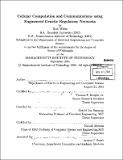| dc.contributor.advisor | Thomas F. Knight, Jr., Gerald Jay Sussman and Harold Abelson. | en_US |
| dc.contributor.author | Weiss, Ron, 1970- | en_US |
| dc.contributor.other | Massachusetts Institute of Technology. Dept. of Electrical Engineering and Computer Science. | en_US |
| dc.date.accessioned | 2005-08-23T18:27:43Z | |
| dc.date.available | 2005-08-23T18:27:43Z | |
| dc.date.copyright | 2001 | en_US |
| dc.date.issued | 2001 | en_US |
| dc.identifier.uri | http://hdl.handle.net/1721.1/8228 | |
| dc.description | Thesis (Ph. D.)--Massachusetts Institute of Technology, Dept. of Electrical Engineering and Computer Science, 2001. | en_US |
| dc.description | Includes bibliographical references (p. 130-138). | en_US |
| dc.description.abstract | In this thesis, I present an engineering discipline for obtaining complex, predictable, and reliable cell behaviors by embedding biochemical logic circuits and programmed intercellular communications into cells. To accomplish this goal, I provide a well-characterized component library, a biocircuit design methodology, and software design tools. I have built and characterized an initial cellular gate library with biochemical gates that implement the NOT, IMPLIES, and AND logic functions in E. coli cells. The logic gates perform computation using DNA-binding proteins, small molecules that interact with these proteins, and segments of DNA that regulate the expression of the proteins. I introduce genetic process engineering, a methodology for modifying the DNA encoding of existing genetic elements to achieve the desired input/output behavior for constructing reliable circuits of significant complexity. I demonstrate the feasibility of digital computation in cells by building several operational in-vivo digital logic circuits, each composed of three gates that have been optimized by genetic process engineering. | en_US |
| dc.description.abstract | (cont.) I also demonstrate engineered intercellular communications with programmed enzymatic activity and chemical diffusions to carry messages, using DNA from the Vibrio fischeri lux operon. The programmed communications is essential for obtaining coordinated behavior from cell aggregates. In addition to the above experimental contributions, I have developed BioSPICE, a prototype software tool for biocircuit design. It supports both static and dynamic simulations and analysis of single cell environments and small cell aggregates. Finally, I present the Microbial Colony Language (MCL), a model for programming cell aggregates. The language is expressive enough for interesting applications, yet relies on simple primitives that can be mapped to the engineered biological processes described above. | en_US |
| dc.description.statementofresponsibility | by Ron Weiss. | en_US |
| dc.format.extent | 138 p. | en_US |
| dc.format.extent | 10811566 bytes | |
| dc.format.extent | 10811322 bytes | |
| dc.format.mimetype | application/pdf | |
| dc.format.mimetype | application/pdf | |
| dc.language.iso | eng | en_US |
| dc.publisher | Massachusetts Institute of Technology | en_US |
| dc.rights | M.I.T. theses are protected by copyright. They may be viewed from this source for any purpose, but reproduction or distribution in any format is prohibited without written permission. See provided URL for inquiries about permission. | en_US |
| dc.rights.uri | http://dspace.mit.edu/handle/1721.1/7582 | |
| dc.subject | Electrical Engineering and Computer Science. | en_US |
| dc.title | Cellular computation and communications using engineered genetic regulatory networks | en_US |
| dc.type | Thesis | en_US |
| dc.description.degree | Ph.D. | en_US |
| dc.contributor.department | Massachusetts Institute of Technology. Department of Electrical Engineering and Computer Science | |
| dc.identifier.oclc | 50151102 | en_US |
